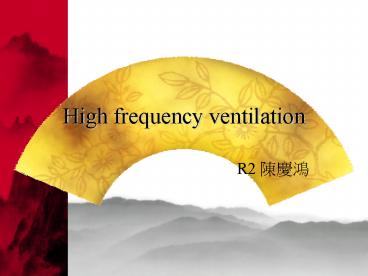High frequency ventilation - PowerPoint PPT Presentation
1 / 21
Title:
High frequency ventilation
Description:
Use in bronchopleural fistula. Minimizing air leaks. PaCO2 ... Bronchopleural, tracheoesophageal fistula. Characteristics of JV. JV. CV ... – PowerPoint PPT presentation
Number of Views:1086
Avg rating:3.0/5.0
Title: High frequency ventilation
1
High frequency ventilation
- R2 ???
2
- Content
- High frequency ventilation
- HPPV
- HFJV
- Characteristics of JV
- Analogy
- HFOV
- Monitoring of HFV
3
- High frequency ventilation
- Produce TV at or below dead space
- High frequency positive pressure ventilation
(HFPPV) - High frequency jet ventilation (HFJV)
- High frequency oscillation (HFO)
4
- Use in major conducting airway surgery
- Use in bronchopleural fistula
- Minimizing air leaks
- PaCO2
- Use in minimizing movement of the operative field
- Minimizing the tidal movement
- Nondependent lung? quiet operative field
- Dependent lung? minimally moving mediastinum
- Gas exchange improved?
5
- High frequency positive pressure ventilation
(HFPPV) - Conventional
- TV 3-4ml/Kg
- Rate60-120/min
- Inspiration/expiration ratiolt0.3
6
- High frequency jet ventilation (HFJV)
- Small cannula or airway
- less interference the surgical field
- Compared with the HFOV?
- Deliver through a standard single-lumen tube
- Pulsed jet, TVlt2ml/Kg
- Rate120-600/min
- Widest use in OR
- Laryngeal, tracheal, bronchial procedures,
emergency management of the airway - Bronchopleural, tracheoesophageal fistula
7
Characteristics of JV
Characteristics of JV
JV
CV
artificial breathing by insufflation of gas
with high velocity via a narrow nozzle
into the open airway
8
Characteristics of JV
JV
CV
Va (Vt - Vd) f
Gas flow is fast, coaxial,partially
simultaneous, inward only Tidal volume ? dead
space
Gas flow slow, bidirectional,
sequential, bulk flow Tidal volume gt dead space
9
- Mechanism
10
Analogy with Railway
O2
CO2
Conventional ventilation
11
Analogy with Railway
Jet ventilation
12
(No Transcript)
13
- Disadvantage of HFJV
- Unfamiliarity
- Inability monitor end-tidal CO2
- Inability to use potent inhalation agents without
pollute the OR - Complication
- Barotrauma
- Mucosal damage
- Tracheobronchitis
- Adequate warming humidification
14
- High frequency oscillation (HFO)
- Piston providing positive and negative
pressure - The oscillator provide the fresh gas and wash out
the CO2 - Rate180-3000/min
- Use in patient with ARDS
15
(No Transcript)
16
Monitoring of HFV
17
- Monitoring of HFV
- Peak airway pressure
- CO2 measurement
- Pulse oximetry
18
- Monitoring of HFV
- pressure
- Drive pressure15-30 psi
- Mean airway pressure measured in trachea at
least 5-10cm below the injector - Air pressure correlate gas exchange
- Peak air pressure ?? PaCO2 ?
- But no unique relationship
- Intrinsic PEEP effect
- High drive pressure
- Inspiratory times
19
- Monitoring of HFV
- CO2 measurement
- The system is open
- Capnography is difficult to apply
- ?artificially low
- Method of measurement
- Capnograph placing in the expired circuit
- Interject a conventional breath periodically to
measure ETCO2 - Compared with the PaCO2 periodically
20
- Multiple reports of the successful application of
HFJV in patients with BPF, it has not proved
universally advantageous in terms of gas exchange - In summary, in view of the limitation of HFV, its
use as a routine procedure for any of the three
possible thoracic surgery situations cannot be
recommended.
21
Thanks for your attention































